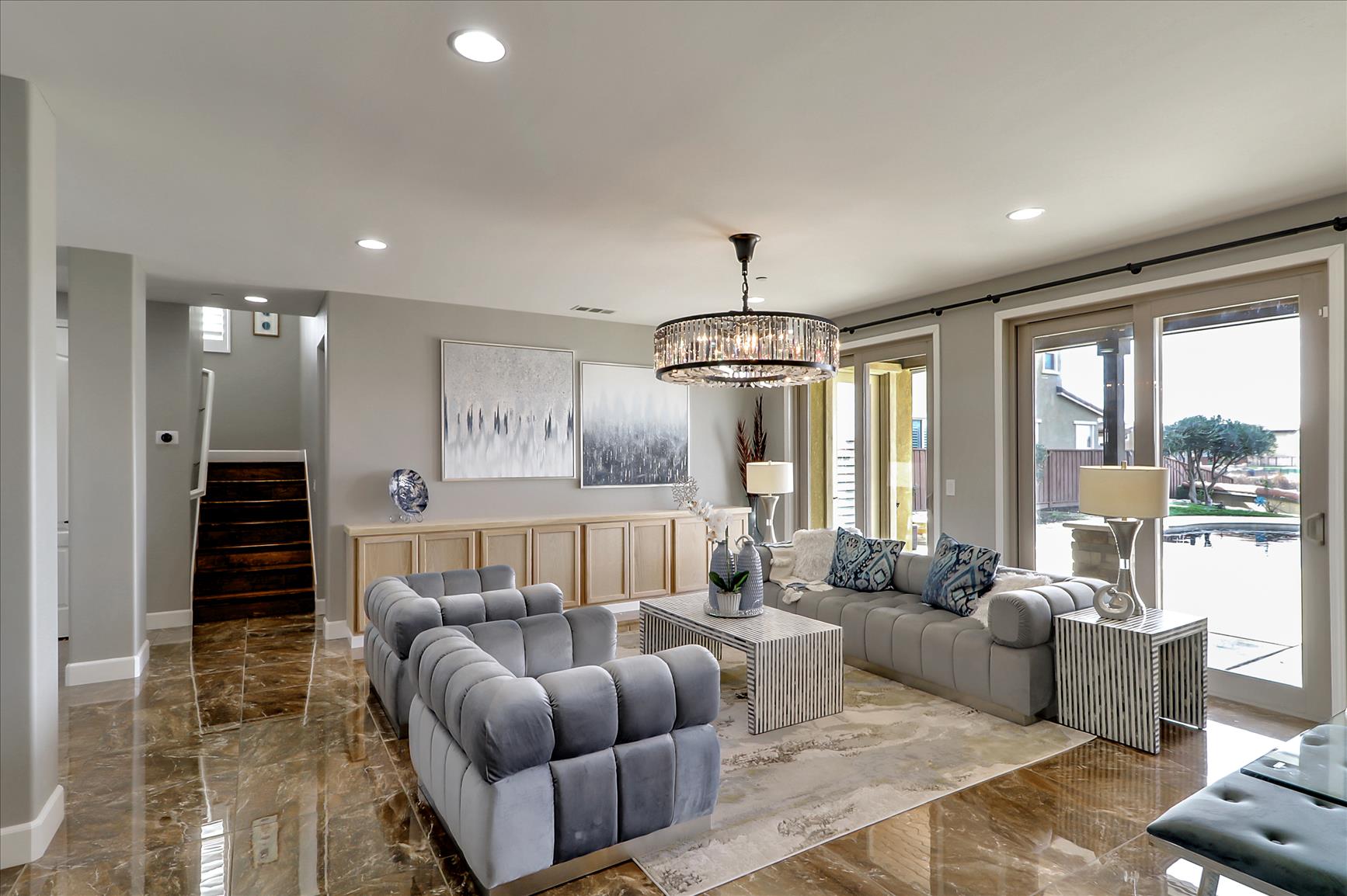
Home lighting in 2021 for a successful interior design scheme
Lighting plays an important role in giving the home a bright and cheerful look. In 2021, as more people will continue to work from home, there is a greater need for the house to be correctly lit-up. Since every room in the house serves a different purpose, the lighting has to be specific to the room. Lighting has to serve a purpose and also look striking. An area like the kitchen will require direct lighting to serve a purpose, while a living room more indirect with attractive fittings. Here is a quick understanding ranging from the best type of lighting for a living room to bathroom lighting. Every top interior designer understands lighting is indispensable for a successful interior design scheme.
Today modern lighting can be controlled using a mobile application and even without getting up from the chair to switch on/off the lights. The combination of light sources, color, and intensity can deliver different looks ranging from a party feel to an intimate mood. There is a wide range of light fittings, but getting home lighting right is no easy task.
Here are few basic things to keep in mind while deciding on the home lighting for individual rooms: –
- The type of fixtures.
- The intensity and color of the light.
- Proper placement of the light fitting alongside furniture, etc.
- Overall style to match the color palette, and décor of the room.
- Groups of mixed light sources – lamp, chandelier, sconce, etc.
- Location of switches, dimmers and control panels.
- Natural light entering the room.
- Energy saving lights.
- Trends and latest technology.
Lighting trends 2021
In 2021, lighting trends range from an elegant swan-neck wall light for a reading area to colorful lava lamps in a calm corner to central pendants as a focal point in a living room. It’s more about creating a personal space to suit one’s style. Here are few lighting trends 2021 to look out for:-
1. Materials
There is no one type of material trending. From warmer tones of brushed and polished brass to natural materials including concrete, marble, wood in high shine, or matt finishes will be in demand. There will also be the use of LEDs (light-emitting diodes) and OLEDs (organic light-emitting diodes) alongside traditional lighting. The key is to mix and match materials and customize the lighting according to the homeowner’s requirement.
2. Style
Modern design elements with traditional concepts will merge chandeliers, pendant lights made of frosted glass sconces, fabric lampshades, and sculptural shapes. To further add to the luxury appeal, designers and homeowners will look for light fixtures that stand out more as a statement-piece than only a light source.
3. Color
In 2021, black, white, and color is the new trend in design. Chandeliers and lamps in matt black, white LEDs and the colorful playfulness of floral Paisley and Ikat in lampshades are trending. Whether you want to emphasize a design idea or have a minimalism approach, the choice of color will tie in the desired look.
4. Horizontal lights
Protruding lights in a horizontal arrangement will be preferred to create an industrial style.
5. Lava Lamps
The retro lava lamps are making a comeback in 2021. With 18.2k Instagram hashtags, lava lamps are trending. Lava lamps have colored lighting and a motion effect that can be a mood booster. Since they are therapeutic they help to unwind and de-stress. They are used in meditation rooms or placed around the home to create tranquillity. Remember to keep them away from direct sunlight and preferably at a room temperature of 68 degrees Fahrenheit.
Lighting in every room
Here are a few room-by-room lighting tips to keep in mind when you design home lighting: –

1. Living room or family room
The living room is a multi-purpose room. It serves as a place where the family interacts, watches TV, and entertains friends. In this room people spend the most time. Thus, experts say use lights that bounce off the ceiling to create brightness and avoid shadows. Also layering effect is particularly important in the living room or family room. Ambient lighting for a living room should be 1,500-3,000 lumens.
Use soffit or valance lighting, recessed or track lighting or plug-in floor lamp with upward-facing globes to light up living rooms. Additional adjustable lamps placed near a reading chair or a reading lamp with an LED or incandescent light bulb on a multi-functional desk serve as task lighting within a living room area.
Both ceiling lights that act as a design focal point and accent lights that serve as highlighters continue in the interior design trends 2021. While ceiling lights will be bold chandeliers or contemporary pendant light shade, accent lights used to highlight the art or other artefacts will include wall sconces, floodlights, recessed lights, torchère lamps, or track lighting. There will be an increase in wall switches or keypads to control all the lighting with pre-programmed ‘entertaining,’ ‘reading,’ ‘all on’ and ‘all off’ settings.

2. Home office
After the COVID-19 lockdown, things are opening up, but many companies have asked their employees to continue to work from home. It means giving more thought to how to light a home-office and work space.
Begin to identify the office tasks that will take place in a home office. The functionality of the work desk or the entire home office room depends on the work. Is it going to be more paperwork, computer work, or talking on the phone? The key consideration here is to ensure that the light fixture does not reflect on the computer screen. Cove lighting, wall sconces, table lamps, and LED task lighting will be required to keep the area bright and white if working after dark. SAD lamps may also be used in home offices to supplement another light source. Ambient lighting for a home office should be between 3,000-6,000 lumens, with task lighting at the desk a minimum of 1,200 lumens.

3. Dining room
Dining rooms need task lighting to feed the family and aesthetic ambient lighting to entertain. In 2021, placing pendant lights above the table, flush mount and recessed on ceilings, and sconces on walls will be a part of kitchen lighting design. The dimmable chandelier over the table will continue to be the eye candy. Only remember while installing a chandelier, it should hang about 33 inches above the table in a dining room with 8-foot ceilings. For every foot above 8 feet, add 3 inches to this standard measurement. In a dining room, ambient and task lighting combined should be 3,000-6,000 lumens.

4. Kitchen
The kitchen is the room that relies on task lighting as most of the food preparation and work happens here. While natural light is of utmost importance, lighting experts augment the natural light with central ceiling-mounted lights, distributed ceiling lights, recessed fixtures, under cabinet lighting, soffit lighting above the sink, and pendant lighting over the island. While installing pendants remember, they should hang about 35-40 inches above a work surface.
Modern kitchen lighting schemes include tape-lights in the toe-kick area (between the cabinet and floor) for late-night trips to the kitchen. In addition, strip lights or downlights to light up the dishes in open shelves or glass-front cabinets are a must. Bright kitchen lighting will be between 5,000-10,000 lumens.

5. Bedroom
The bedroom is a room that has to have a relaxing atmosphere. Ambient architectural lighting for bedrooms includes bedside lamps, floor lamps, or a pair of sconces flanking the wall mirror. 2021, will also see a rise in eye-catching central pendants as focal points used in bedrooms.
Try to use more wall fittings over a central ceiling-mounted fixture. Also, switches with dimmers are good when paced within easy reach of the bed. Proper closet lighting also needs due consideration. Ambient lighting in the bedroom should be 2,000-4,000 lumens.

6. Bathroom
Bright lights make safe bathrooms. A bathroom requires 4,000-8,000 lumens, with task lighting at the mirror at a minimum of 1,700 lumens. A bathroom requires sufficient lighting for a mirror. Central ceiling-mounted fixtures that cast shadows are a big no, no. Instead, USE sconce lights on both sides of the mirror. Wall-mounted fixtures can be ADDED, on the opposite wall of the mirror or above the bathtub.

7. Entryways, hallways, stairs
Entryways, hallways, or transition areas between rooms don’t need very bright lights. Flush-mount ceiling fixtures or sconces along the wall for indirect lighting are perfect to light up this area. But of course, if your entryway has artwork, family photographs, or architectural elements, it will require accent lighting. In this case, directional light fixtures that use light bulbs emitting very narrow beams of light may be perfect. PAR (parabolic aluminized reflector) and MR (multi-faceted reflector) light bulbs are recommended for accent lighting in these areas.
A double-height entry with a staircase will look attractive with a modern focus chandelier. Don’t forget to place the lighting controls at both the bottom and top of the stairs. These areas require only about 1,200-2500 lumens of lighting. If the area is much larger, it can go up to a maximum of 4000 lumens.

8. Outdoors
Today, many manufacturers produce lights for a terrace or porch that work on a charge or solar energy instead of traditional wiring. These lights are portable and easy to move around. Of course, all portable lights are not favorable, but a few are okay to interchange as and when.
Outdoor lighting or landscape lighting includes low-levels of lighting distributed from porch lighting to mid-range and far corner of the property. It is, directed towards security more than aesthetics. Outdoor lighting at the front entry should be 1,000-2,000 lumens and around 300 lumens on pathways.
Avoiding lighting mistakes
If you have a top interior designer who is taking care of your lighting, you will never land up with mistakes, like: –
Creating an undesired mood with the wrong lighting,
Unable to work from home due to insufficient light,
Working in a dimly lit kitchen,
Tripping over in dark areas as full-functionality not considered,
Shining a spotlight wrongly that casts a shadow over the center-piece,
Unclear reflection in the mirror, or
Unable to enjoy modern conveniences.
Conclusion
In 2021, it is all about individuality. Lighting does not require to match but blend in with other finishes. Only remember to keep all your lighting, whether it is recessed lights, pendants, or chandeliers, or sconces, no more than 6 to 8 feet apart from each other. That way, you can achieve professional-looking lighting in your home. Also, lighting should come from several sources rather than one central source to create a mix of functionality – work, play, relax. As mistakes in light design can turn the most beautiful spaces into undesirable and uncomfortable areas, it is essential that you get the final mix of lighting just right. Today, automation specialists are called-in by interior designers to install and configure electrical equipment. Also homeowners are more aware now and opting for energy saving lights or green energy. Get it right, to make your home, light up your life!
